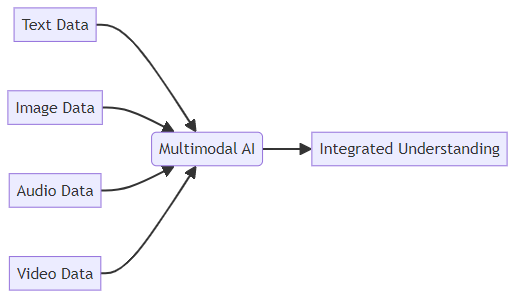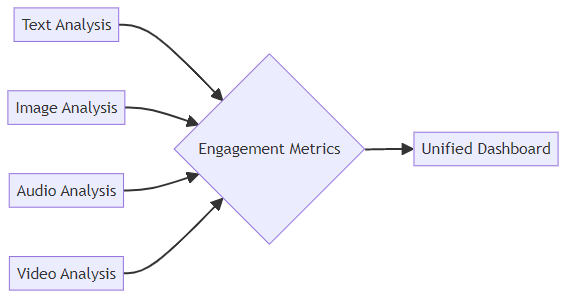Supercharge Your Social Media: How Multimodal AI Drives Engagement
Understanding Multimodal AI and Its Impact on Social Media
Did you know that social media users now spend an average of 147 minutes per day on these platforms? That's according to Statista, with their data from 2023. This is where multimodal ai comes in, offering a new way to boost engagement.
Multimodal AI is a type of artificial intelligence that processes and combines different types of data. This includes text, images, audio, and video. Unlike traditional ai, which focuses on one type of input, multimodal ai aims for a more complete understanding of content. For example, it can generate captions for images, summarize videos, and analyze sentiment using both text and audio cues.

In the early days, social media marketing relied on basic ai such as chatbots and keyword analysis. Today, you see ai powering analytics, content recommendations, and ad targeting. Now, multimodal AI is emerging, enabling content strategies that are more nuanced and engaging.
- Enhanced content understanding: Ai can now "see," "hear," and "read" content much like a human would. This allows for more accurate interpretation and context.
- Improved personalization: By analyzing diverse data, ai can tailor content to individual user preferences. For instance, an e-commerce platform might use image analysis to recommend products based on a user's style preferences.
- Increased creativity and efficiency: Multimodal ai automates content creation while maintaining quality. This helps content creators save time and resources.
As Kim et al. (2024) point out, Stanford Screenomics is developing open-source platforms for multimodal data collection.
Now that we understand the capabilities of multimodal ai, let's delve into how these capabilities can be leveraged to create more engaging social media content.
Creating Engaging Content with Multimodal AI
Ready to create more engaging social media content? Multimodal ai can help you analyze visuals, generate captions, and personalize content for different platforms.
Multimodal ai can analyze images and videos to identify trending visual styles and themes. This helps you stay current with what captures audience attention. You can then use these insights to inform the visual elements of your own content.
Ai also helps analyze competitor visuals to identify what works and what doesn't. By understanding competitor strategies, you can find gaps and opportunities to differentiate your content.
Tools for automated image and video tagging and categorization can streamline your content management. This makes it easier to find and reuse visuals, saving time and resources.
- For example, ai can detect that user-generated content (UGC) featuring a specific product has high engagement. A retail brand could then use this data to create ads featuring similar UGC, boosting the ad's relevance and potential impact.
Ai-powered caption generators can tailor text to match the visual content, enhancing the overall message. These generators use multimodal analysis to understand the image or video and create relevant, engaging captions.
Ai can also assist with script writing, helping you craft compelling video narratives. By analyzing successful video content, ai can suggest plot lines, dialogue, and visual cues to capture audience attention.
- For example, a healthcare organization can use ai to create short, informative videos about common health issues, complete with engaging visuals and easy-to-understand scripts.
Multimodal ai enables automated content adaptation, resizing and reformatting visuals for different platforms. This ensures your content looks its best on Instagram, Facebook, TikTok, and other social media channels.
Ai can also provide platform-specific style recommendations, suggesting optimal visual elements for each channel. This helps you tailor your content to meet the unique preferences of each platform's audience.
- For example, ai might suggest a different color palette for a LinkedIn post compared to an Instagram story, ensuring each piece of content resonates with its target audience.

By automating these tasks, you can focus on higher-level creative strategies and campaign development.
Next, we'll examine how multimodal ai optimizes hashtag research and content distribution.
Automating Social Media Tasks with Multimodal AI
Did you know that automating tasks can save you up to 20 hours per week? That's according to a LinkedIn article from 2023. Multimodal ai is changing how we handle social media, making it easier to manage and optimize your online presence.
Let's break down some of the ways ai can help:
Optimization and Efficiency
- AI-driven scheduling helps you post content when user engagement is highest. Ai analyzes user behavior to identify optimal posting times. This ensures your content reaches the largest audience possible.
- For example, an ai might determine that video content on Facebook sees peak engagement between 6 PM and 9 PM on weekdays. This allows you to schedule posts to align with these peak hours.
- Cross-platform publishing adapts and distributes content across multiple channels. Ai automatically adjusts content formats for different platforms. This saves time and ensures consistent branding.
- For instance, a marketing team can use ai to resize images and rewrite captions for Instagram, Twitter, and LinkedIn. This ensures content looks its best on each platform.
- Automated A/B testing optimizes posting times and content formats based on performance. Ai tests different variables to identify what resonates best with your audience. This helps refine your content strategy over time.
- For example, a retail brand can use ai to automatically test different versions of ad copy on Facebook, identifying which version drives the most conversions.
Community Management and Engagement
- Sentiment analysis identifies and responds to positive and negative comments. Ai can automatically detect the tone of user comments. This allows you to prioritize responses to negative feedback and engage with positive comments.
- For example, a customer service team can use ai to identify and respond to urgent complaints on Twitter, ensuring customer issues are addressed promptly.
- Chatbot integration automates customer service and answers FAQs. Ai-powered chatbots can handle routine inquiries. This frees up human agents to focus on more complex issues.
- For instance, a healthcare provider can use a chatbot to answer common questions about appointment scheduling, freeing up staff to handle more critical tasks.
- Spam and bot detection maintains a clean and authentic online community. Ai can identify and remove spam and bot accounts. This ensures genuine engagement and protects your brand reputation.
- For example, a social media platform can use ai to detect and remove fake accounts that spread misinformation or engage in fraudulent activities.
Content Visibility and Strategy
- AI-driven hashtag suggestions find relevant and trending hashtags. Ai analyzes current trends to suggest hashtags that will increase your content's visibility. This helps you reach a wider audience.
- For example, an ai might suggest using hashtags related to "sustainability" for a post about eco-friendly products, increasing its reach among environmentally conscious consumers.
- Performance analysis tracks hashtag effectiveness and adjusts strategies. Ai can monitor which hashtags drive the most engagement. This allows you to refine your hashtag strategy for better results.
- For instance, a marketing agency can use ai to track the performance of different hashtags on Instagram, identifying which ones generate the most likes, comments, and shares.
- Competitor analysis identifies successful hashtags used by industry leaders. Ai helps you understand what hashtags are working for your competitors. This allows you to adapt their successful strategies to your own content.
- For example, a fashion brand can use ai to analyze the hashtags used by its competitors on Instagram, identifying opportunities to reach a similar audience.
By automating these social media tasks, you can save time and improve your content's performance.
Next, we'll dive into how multimodal ai elevates social listening and monitoring.
Analyzing Social Media Performance Using Multimodal Data
Are you tired of guessing what resonates with your audience? Multimodal ai can transform your social media analytics, providing deeper insights into performance.
Multimodal ai enables a unified dashboard that visualizes data from various sources like text, images, audio, and video. This comprehensive view helps you correlate engagement metrics across different content types.
- For example, you can analyze how the aesthetics of an image correlate with the sentiment expressed in the comments. This helps in understanding which visual elements drive positive reactions.
- A marketing team can use this data to optimize their content strategy, ensuring that posts are both visually appealing and emotionally engaging.

With multimodal ai, you can perform advanced sentiment analysis, detecting nuanced emotions from text and audio. This goes beyond simple positive or negative classifications.
- For instance, ai can identify sarcasm or subtle dissatisfaction in user comments. This helps you understand the true sentiment behind the engagement.
- By identifying patterns in content consumption, ai can map user preferences. This allows you to deliver personalized recommendations that align with individual needs, boosting engagement and satisfaction.
Multimodal ai helps in forecasting trends by analyzing vast amounts of data. This allows you to anticipate upcoming social media themes and align your content accordingly.
- By identifying underserved topics and formats, ai enables content gap analysis. This helps you create content that fills these gaps, attracting a larger audience.
- For example, a financial institution can use ai to predict trending investment topics and create informative videos, attracting potential clients.
Multimodal ai also enables optimized resource allocation based on predicted roi. This ensures you’re investing in content that is most likely to drive results.
Now that you know how to analyze social media performance, let's explore how multimodal ai elevates social listening and monitoring.
Best Practices and Ethical Considerations for Multimodal AI in Social Media
Are you ready to navigate the ethical maze of multimodal ai? Using ai responsibly is crucial to maintaining user trust and avoiding potential pitfalls.
Protecting user data is paramount. Implement robust security measures to prevent unauthorized access and data breaches.
- For example, healthcare providers must ensure that ai systems comply with HIPAA regulations when processing patient data. Similarly, financial institutions must adhere to regulations like GDPR when handling customer financial information.
- Transparency is also key. Clearly communicate how ai uses user data for content creation and personalization. This builds trust and allows users to make informed decisions about their data.
Complying with data privacy regulations like GDPR and CCPA is not optional. These regulations set strict guidelines for data collection, storage, and usage.
- Organizations must obtain explicit consent from users before collecting their data. They must also provide users with the right to access, rectify, and erase their data.
- For example, a social media platform using ai to analyze user-generated content must inform users about this practice in its privacy policy. It should also provide users with options to control their data settings.
Ai models can inadvertently perpetuate biases present in the data they are trained on. Regularly audit ai models to identify and mitigate potential biases in content generation and targeting.
- For instance, an ai used for ad targeting might disproportionately show certain job opportunities to specific demographic groups.
- Promote diversity and inclusivity in both visual and textual content. This ensures that your social media presence resonates with a broad audience.
Monitor ai outputs for unintended discriminatory outcomes. Implement feedback mechanisms that allow users to report biased or inappropriate content.
- For example, a content moderation system should be designed to detect and flag hate speech and misinformation, regardless of the source. Regular testing and updates are essential to refine the system's accuracy and fairness.
Ethical Considerations for AI-Powered Virtual Influencers
The rise of AI-powered virtual influencers presents unique ethical challenges. It's important to be transparent about their nature and avoid misleading audiences.
- Disclosure is key: Clearly indicate when content is created or presented by a virtual influencer. This prevents audiences from believing they are interacting with a real person.
- Authenticity and representation: Ensure virtual influencers promote diverse perspectives and avoid perpetuating harmful stereotypes. Their creation and portrayal should be mindful of inclusivity.
- Data privacy: Be cautious about how data is collected and used in interactions with virtual influencers, especially if they are designed to mimic human interaction.
While ai can enhance content creation, it's important to maintain a human touch. Disclose the use of ai in content creation where appropriate to build trust with your audience.
- For example, if an ai is used to generate captions for images, consider adding a disclaimer such as "AI-assisted caption."
- Prioritize human oversight and creativity to ensure genuine engagement. Ai should serve as a tool to augment human capabilities, not replace them entirely.
Building trust requires openness about ai's role. Clearly state how ai is used to personalize content, recommend products, or automate customer service.
- For example, an e-commerce platform can explain how ai-powered recommendations are generated based on users' browsing history and purchase patterns. This transparency helps users understand and appreciate the personalization process.
By following these practices, you can harness the power of multimodal ai while upholding ethical standards and building lasting relationships with your audience.
Next, we'll discuss future trends and innovations in multimodal ai for social media.
The Future of Social Media with Multimodal AI
The future of social media is here, and it's powered by multimodal ai. Are you ready to see what's coming next?
Generative AI will create visuals and content formats. Imagine ai crafting ads tailored to each user's style.
AI-powered virtual influencers will engage audiences. These ai characters connect with users in new ways.
Real-time content adaptation will adjust content based on immediate user feedback. Content will evolve to stay relevant.
Content creators will focus on strategy and creativity, guiding ai to achieve marketing goals.
Human-ai collaboration will combine human intuition with ai capabilities. Ai will augment human skills.
Content creators will develop skills to use and manage ai tools.
Invest in ai training and education to stay ahead.
Experiment with different ai tools and platforms.
Stay informed about the latest ai developments and ethical considerations.
By embracing these changes, you can harness the power of multimodal ai.


